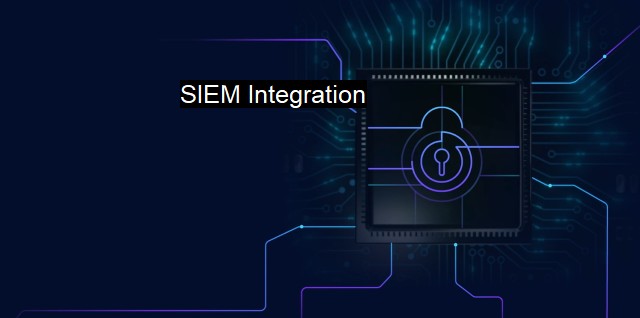What is SIEM Integration?
The Importance of SIEM-Antivirus Integration in Modern Cybersecurity Strategy
Security Information and Event Management (SIEM) integration is an essential aspect of cybersecurity infrastructure among businesses across various industries. This technology combines two cybersecurity functionalities: Security Information Management and Security Event Management. Both the functionalities are intrinsically designed to offer a robust, unified approach towards the identification of potential security threats, incidents, and vulnerabilities in an organization’s network system.SIEM as a technology solution provides organizations with a comprehensive view of their IT security landscape. This can be highly beneficial in terms of digital threat detection, regulatory compliance, and ultimately ensuring the proper functioning of systems in a continuously threatened digital ecosystem.
At the core of SIEM is the capability to collate data from multiple sources within an organization's cyber landscape, analyze this data for patterns resembling cyber-attacks, send alerts, and unify the information in user-friendly dashboards that facilitate IT enterprises to have an overall picture of their IT security. This functionality of SIEM becomes essential in the context of modern, complicated information systems where threats can arise from anywhere and can take many different forms.
SIEM integration effectively manages the data logs generated by applications, antivirus software, and firewall programs within a given system. This disparate data is then processed and analyzed for abnormalities. In scenarios where data anomalies represent unlawful activities, the SIEM system will activate an immediate signal indicating a potential security breach.
Specifically, within the antivirus framework, SIEM plays a crucial role. In a typical scenario, the antivirus software detects and neutralizes threats at the device level, confining each process to an individual machine. it may not have the automated synchronization capability to expose data or threats across systems without centralized management, which is where the SIEM integration comes into play.
SIEM integration combines data from different security software, including antivirus programs. It takes the information generated by these solutions, centralizing and progressing it into a searchable format. This capability allows system administrators to search through data rapidly and identify potential threats before they can exploit vulnerabilities.
Another factor that makes SIEM significant is its preemptive approach towards potential threats. SIEM correlates suspicious activities across the network and deploys smart algorithms to identify abnormal behavior, ensuring quick detection and shorter response times. Integrating SIEM with antivirus software can enhance the effectiveness of threat detection by harnessing one system’s strength and addressing its limitations using another system’s capabilities.
Notably, in addition to integrating data from antivirus systems, it would be beneficial to have SIEM that is designed to connect with intrusion detection systems, vulnerability management solutions, and other essential security tools. This brings forth a significant increase in visibility across the system and results in a much stronger defense against cyber threats. SIEM integration essentially builds a collective defense system, considering not only the occurrence of the anomalies detected by antivirus solutions but also their correspondence with other suspicious activities within the system.
Simultaneously, for governments set to regulate the data security practices of industries, SIEM helps to interpret complex data into simple, actionable insights for better decision-making. It automates compliance auditing and makes an organization ready for sudden compliance audits.
SIEM integration, by possessing the ability to monitor, manage, analyze and visualize events taking place in real-time across the network, has been game-changing for organizations that rely heavily on IT infrastructures. It offers threat intelligence services that can monitor the entire network actively, enhancing one’s ability to predict, detect and respond to security incidents, track the accountability of incidents and ensure that the flows of the subset of a network are under regular scrutiny.
Evidently, SIEM integration is an essential consideration for any organization actively seeking to fortify their security infrastructure. By leveraging this technology with various other security software like antivirus programs, one can build an elaborate defense system that proactively prevents cyber threats, offers valuable insights, and fosters a secure and compliant digital environment.

SIEM Integration FAQs
What is SIEM integration in cybersecurity?
SIEM (Security Information and Event Management) integration is the process of integrating different cybersecurity technologies, such as antivirus software, firewalls, and intrusion detection systems, into a central SIEM system.Why is SIEM integration important for antivirus software?
SIEM integration is crucial for antivirus software because it allows the software to work in conjunction with other security tools, providing a more comprehensive view of the network and increasing the likelihood of detecting and mitigating threats.What are the benefits of SIEM integration for cybersecurity?
SIEM integration provides numerous benefits, including improved threat detection and response times, better network visibility, reduced false positives, and easier compliance with industry regulations.How does SIEM integration improve the effectiveness of antivirus software?
SIEM integration can improve the effectiveness of antivirus software by providing real-time alerts and notifications, enabling automated response to threats, and allowing for more efficient incident investigation and remediation. Additionally, SIEM integration can help identify patterns and trends that may indicate ongoing or evolving threats.| | A | | | B | | | C | | | D | | | E | | | F | | | G | | | H | | | I | | | J | | | K | | | L | | | M | |
| | N | | | O | | | P | | | Q | | | R | | | S | | | T | | | U | | | V | | | W | | | X | | | Y | | | Z | |
| | 1 | | | 2 | | | 3 | | | 4 | | | 7 | | | 8 | | |||||||